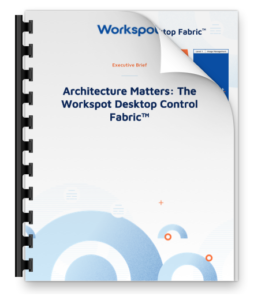The Shift from On-Premises to Cloud-Based Desktop Virtualization
By Matthew Davidson and Michael Keen
It has been stated thousands of times through the years, “Change presents opportunities.” The ability to adapt to change is a key advantage in business. To survive, compete, and win, enterprises must adapt. However, because change can be disruptive and expensive, organizations tend to resist it, and few are prepared to consistently take advantage of the opportunities that change presents.
An emerging competitive advantage is leveraging cloud-based desktop virtualization, also known as Cloud PCs. What is new today often becomes core tomorrow, and we strongly believe that organizations should be looking to Cloud PCs as their next competitive advantage.
In the Beginning…
In 2002, server virtualization was born. VMware emerged as the category king with the release of their hypervisor, ESX Server. Server virtualization forever changed the IT landscape by allowing businesses to consolidate multiple servers onto fewer physical servers, boosting performance, streamlining IT administration, and reducing costs. As time went on, more vendors jumped into the space: In 2007, Citrix introduced XenServer; a year later in 2008, Microsoft entered the arena with Hyper-V.
With servers being virtualized, desktops came next. On-prem Virtual Desktop Infrastructure (VDI) has been around since the early 2000s and really started taking root in 2006, with the release of VMware’s Virtual Desktop Manager (later renamed View and then Horizon), and the Citrix XenApp and XenDesktop offerings (later rebranded Citrix Virtual App and Desktops). Microsoft entered the space in 2008 with the introduction of Hyper-V.
Just as server virtualization changed the way technologists built and implemented infrastructure technology, and most importantly, how they strategized around it to support the growth of the business, they are now finally able to do the same with desktop virtualization.
What are the Main Types of Desktop Virtualization?
The three most popular types of desktop virtualization:
- Virtual desktop infrastructure (VDI)
- Remote desktop services (RDS)
- Desktop-as-a-Service (DaaS)
Cloud vs. On-Prem
By transitioning virtual desktops to the cloud, in lieu of being managed and deployed locally, companies can quickly realize all the promised benefits of centralized management, improved data security, simplified deployment, and scalability. The other opportunities, like Cloud PCs and cloud workstations, afford IT organizations is the ability to put the compute as close to the user as possible, thereby reducing latency, improving end-user performance, and providing a great user experience.
Gone are the days of technology groups being in the hardware business. It is extremely costly to keep up with the computing demands of software, especially GPU requirements. You no longer need to schedule maintenance windows and spend countless hours in the middle of the night swapping and upgrading hardware. With a few clicks of your mouse, you can add CPU, RAM, hard disk space, and so on.
Your CapEx cost now becomes OpEx, and as employees transition in and out of the business, you can configure the virtual desktop to their specific needs. You no longer need to have piles of physical computers sitting idle on a shelf waiting for the “right” user to come along.
As a technologist supporting your business, utilizing Cloud PCs will enable the business and your HR team to consider candidates from a worldwide talent pool. They will be able to hire anybody in the world to work from anywhere and from any device. Talk about a competitive advantage!
Risk Considerations
There is always risk associated with compute that a business must consider, plan for, and most importantly, strategize around – for both on-prem and in the cloud. It sometimes feels like (speaking from my previous life) as an IT leader, you are constantly trading one set of issues and concerns for another. However, the many rewards that organizations can realize by moving desktop workloads to the cloud far outweigh the risks.
Conclusion
A cloud-based desktop virtualization implementation will only be successful if you develop a clear vision and strategy to meet your organization’s current and future business goals. Just like it was in the early 2000’s with server virtualization, it is more than just turning on or spinning up a virtual desktop in your cloud tenant; the right strategy is key.
Related Resources
In case you want to revisit them, here are the first two posts in our digital transformation blog series:
- The New Adaptive Enterprise Competitive Advantage: Cloud PCs
- Cloud PCs Are a Strategic Imperative NOW
Stay tuned as we continue to dive deeper!



